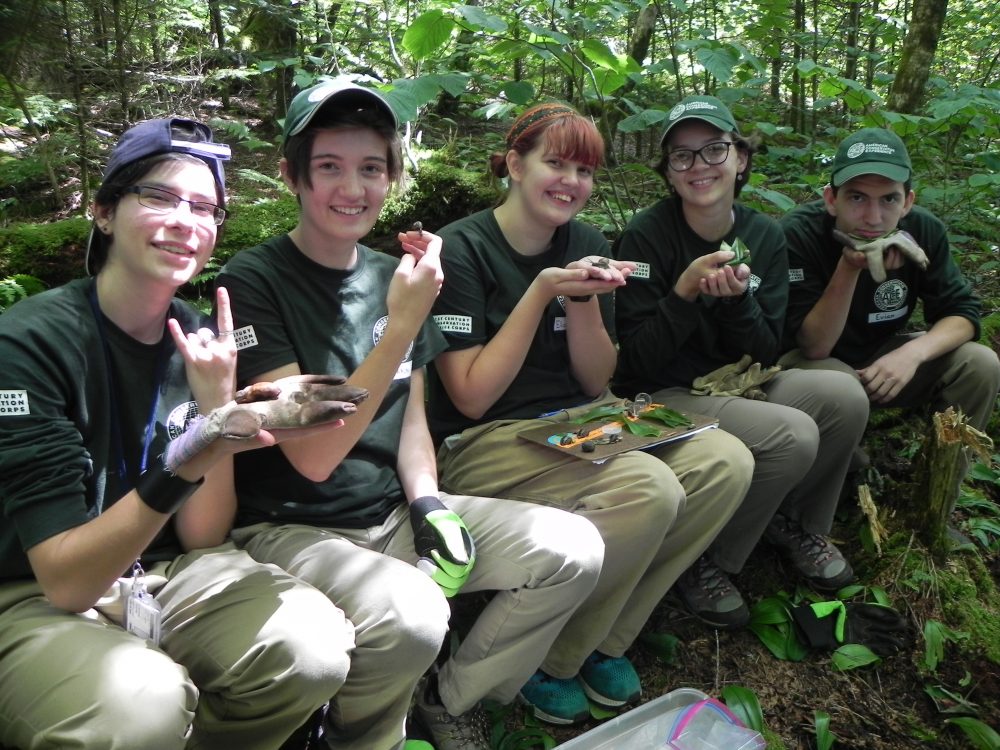by Eliza Watson
2017 graduate of Swain County High School, North Carolina
As part of the GSMNP Summer Internship program, we interns traveled along the Blue Ridge Parkway on the hunt for snails, slugs and millipedes.
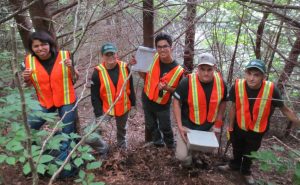
With assistance and knowledge provided by Paul Super, GSMNP Science Director, we were tasked with helping him on the final day of snail survey collections.
Using the advanced mapping systems of ArcGIS, we were directed to specific locations considered suitable for the organisms we were to hunt diligently for. Each location along the parkway was selected based on soil type, tree presence and various other attributes that influence or encourage the presence of snails and millipedes.
Process for collecting snails
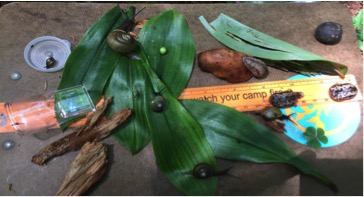
Each of the two groups was provided packets containing the coordinates of our sites, shaker boxes, vials to contain the snails small enough to capture, vials of ethanol for the millipedes, and paper bags and vials for any empty shells.
Our responsibility was to document the number of empty shells, live snails, live slugs and millipedes we located.
In this process, we also were responsible for identifying the types of areas we were examining, whether they be dense forest or thin shrubbery. Each area we searched, such as logs, leaves and tree snags, were also noted in the paperwork we kept.
We donned our Personal Protective Equipment, which for this excursion meant wearing gloves, as we were to be digging through the leaf litter of the sites in search of millipedes and snails. Using a GPS, we traveled off the beaten path into the wilderness in search of the location sites assigned to our small groups.
The first site was comprised of dense vines, low-lying shrubs, thorns and ivy (both poison ivy and other types of ivy). Although the path down to the first site was difficult to traverse, both groups were able to make it to the desired location with only minor cuts and complaints.
We scoured the ground for dense leaf-packets to place in the shaker boxes. The boxes were made of two plastic containers. One container had a screen so that when shaken the smaller particles from the litter would fall through to the second container to be sifted through for millipedes and small snails.
As the day went on and we traveled further into the park, our ventures increased in productivity.
Finding snails and millipedes
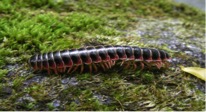
Upon reaching the second site, my group found an abundance of the Vitrinizonites latissimus species of snail (common name is glossy grapeskin). In this mossy, secluded area along the highway, we also discovered many red, yellow and white banded millipedes.
As my group approached the final site on our list, we discovered that we would have to branch off and venture to an alternative site — sites provided when the site indicated by ArcGIS is too difficult to reach. Within this area, we stumbled upon an area in which snails were plentiful. Under each overturned tree, snag or rock, there were snails and slugs. My group collected nine snails and seven millipedes.
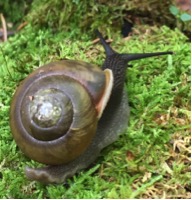
We took the time not only to examine but to enjoy the presence of our little friends. My group members and I took to affectionately naming each one. The snail we measured to be the largest in size (a hefty 8cm) was dubbed “Calvin.”
This experience truly touched my heart, as it allowed me to garner a greater appreciation for the smaller organisms residing within the park.
Research has always been a passion of mine, but never have I gotten to experience field research of this kind involving a creature I once deemed unworthy of close study.
Snail hunting was perhaps the last thing I would have anticipated being one of my most cherished experiences. I realized that although the time we shared together in this internship was brief, it was during snail hunting that we all came to appreciate both the greater aspects of the park as a whole as well as what lies beneath the surface.
The photo at the top of the post shows one group of the interns with some of their finds. Left to right: Danielle Burkett, Marin Carr-Quimet, Eliza Watson, Mary Helmer and Evian Morissette. Empty snail shells and small live snails were collected for research, with the intent to keep the small, live snails alive. Data was taken regarding size for larger snails, as well as photo documentation. Large, live snails were then released back to where they were found. Photo by Erin Lamm
************
This is the second blog post by high school students who participated in the Great Smoky Mountains National Park Summer Internship Program. The students represent high schools in North Carolina and Tennessee that are near Great Smoky Mountains National Park. Read Bryce Trull’s post that provides an overview of the internship program.
The program is funded by both the Youth Partnership Program and Friends of the Smokies. FOTS has supported the program for 16 years, initially providing the salaries for the interns and now funding the program staff salaries.
The program is designed to give the interns a little taste of a variety of activities that rangers are involved with – from fisheries science to botany to forest and stream ecology. The interns gain an understanding of how the park is managed and are introduced to possible career opportunities.
To support programs like this, make a donation today!
